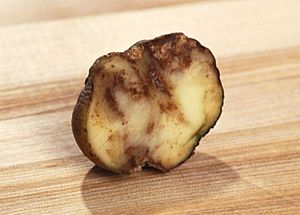European Potato Failure facts for kids
The European Potato Failure was a huge food crisis in the mid-1840s. It happened across Northern and Western Europe. This crisis was caused by a plant disease called potato blight. Many people call this time the Hungry Forties.
The potato failure caused a lot of hardship and deaths. It hit the Scottish Highlands especially hard. But it was even worse in Ireland. Many people died because they did not have enough food to eat.
What Happened to Potatoes
In 2013, scientists looked at old potato samples from museums. They used DNA sequencing to study the DNA of the plant disease. This disease caused the potato blight in 1845.
They compared these old samples to modern types of the disease. The scientists found that the old disease was different. It was not like any of the modern types they studied.
After the blight, new types of potatoes came to Europe. These potatoes came from the Chiloé Archipelago. Before this, most European potatoes came from Peru.
| Potatoes | Rye | Wheat | Oats | ||||
|---|---|---|---|---|---|---|---|
| arable land | consumption | 1845 yield | 1846 yield | ||||
| (%) | (kg/capita daily) | (% change on normal) | |||||
| Belgium | 14% | 0.5/0.6 kg | −87% | −43% | −50% | −10% | n/a |
| Denmark | 3% | 0.2/0.3 kg | −50% | −50% | −20% | −20% | n/a |
| Sweden | 5% | 0.5/0.6 kg | −20–25% | −20–25% | −10% | −10% | n/a |
| France | App. 6% | 0.5 kg | −20% | −19% | −20% | −25% | n/a |
| Württemberg | 3–8% | n/a | −55% | −51% | −15% | −24% | n/a |
| Prussia | 11% | 1.0/1.1 kg | n/a | −47% | −43% | −43% | n/a |
| Netherlands | 11% | 0.7 kg | −71% | −56% | −47% | −6% | n/a |
| Spain | 2% | low | n/a | n/a | n/a | n/a | n/a |
| Highlands of Scotland | n/a | high | n/a | −80% | n/a | n/a | n/a |
| Ireland | 32% | 2.1 kg | −30% | −88% | n/a | n/a | −33% |
| Source: Cormac Ó Gráda et al., 2006 | |||||||
How Populations Changed
The potato crisis had a huge impact on Ireland. It was much worse there than anywhere else. About one million people died. Up to two million people became refugees, meaning they had to leave their homes. This also led to a century-long population decline in Ireland.
Outside of Ireland, about 100,000 people died from the crisis. Most of these deaths were in Belgium and Prussia. In Belgium, about 40,000 to 50,000 people died. The Flanders area was hit very hard. In Prussia, about 42,000 people died. About 10,000 people died in France due to famine-like conditions.
People suffered in many ways, not just from death. Famines also cause fewer babies to be born. This can affect the population for a long time. In Ireland, the number of births dropped by one-third. This meant about 0.5 million "lost lives." Other places had smaller drops. Flanders lost 20–30% of births. The Netherlands lost about 10–20%, and Prussia about 12%.
Many people left their homes to escape the famine. This was most common in Ireland and the Scottish Highlands. In other parts of the United Kingdom and Europe, conditions were not as severe. People did not need to move in such large numbers.
Over 16,500 people left the Scottish Highlands. Many landlords helped them move. The Highland and Island Emigration Society also helped. Most went to North America and Australia. This was part of the Highland Clearances. The crisis led to a large Irish diaspora around the world.
| Annual population change | |||||||
|---|---|---|---|---|---|---|---|
| 1840–45 | 1845–46 | 1846–47 | 1847–48 | 1848–49 | 1849–50 | 1850–60 | |
| Belgium | +1.1% | +0.9% | +0.9% | +0.0% | +0.5% | +0.2% | +0.7% |
| Denmark | +1.1% | +1.0% | +0.8% | +1.0% | +1.0% | +1.0% | +1.2% |
| Sweden | +1.1% | +0.8% | +0.6% | +1.0% | +1.3% | +1.2% | +1.0% |
| France | +0.5% | +0.7% | +0.4% | +0.1% | +0.3% | +0.0% | +0.5% |
| Germany (total) | +1.0% | +1.0% | +0.5% | +0.2% | +0.1% | +0.9% | +0.7% |
| Prussia | +1.3% | +1.4% | +0.8% | +0.5% | +0.4% | +0.9% | +1.0% |
| Netherlands | +1.1% | +1.1% | +0.3% | −0.2% | +0.1% | +0.3% | +0.7% |
| +1.2% | +1.2% | +0.7% | +0.7% | +0.7% | +0.7% | +1.3% | |
| Ireland | +0.4% | −0.2% | −4% | −4% | −4% | −4% | −1.7% |
| Notes: *excluding Ireland | |||||||
| Source: Cormac Ó Gráda et al., 2006 | |||||||
See also
 In Spanish: Penuria europea de la patata para niños
In Spanish: Penuria europea de la patata para niños


